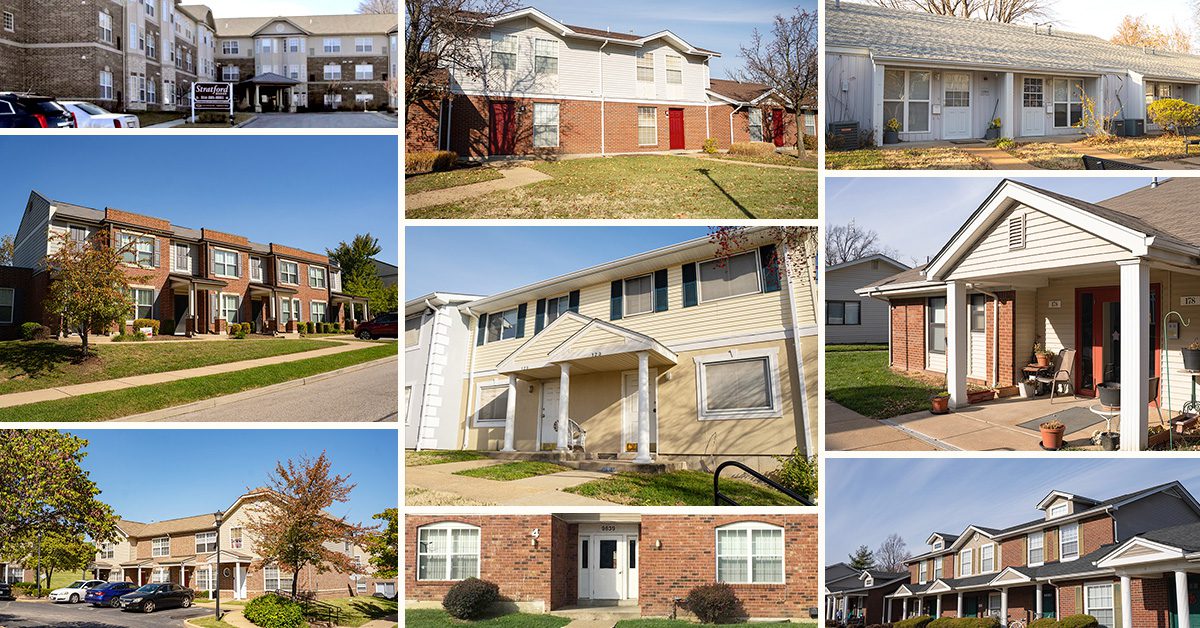Over the past three years, the Housing Authority of St. Louis County has been taking steady steps toward making a greater impact. Its new approach centers on the importance of establishing relationships with residents who need an affordable place to live, making their experience more welcoming and transparent.
Until recently, most of the changes have been internal—but now the housing authority has a new brand, a new website, and a new presence as County Housing.
“I have been excited about how things are changing, but it hasn’t been necessarily visible from the outside,” said Chief Operating Officer Katrina Sommer. “The new brand is an alignment of our goals that other people get to see.”
Those goals include improving overall operations, fostering a resident centered culture, increasing partnerships in the community, expanding access to affordable housing, and changing its public perception from an overly bureaucratic government entity to a warmer, more empathetic organization whose staff genuinely wants to help.
“In the past, our work has often gone unnoticed unless there was a problem,” said Executive Director and CEO Shannon Koenig. “We want to elevate awareness of the solutions we provide and the positive impacts we have on people’s lives and the community we serve.
The 72-year-old agency is not alone in rebranding, she added. County Housing is on the vanguard of a trend among the 3,000 housing authorities across the United States to update their brand toward goals such as increasing partnership opportunities, recruiting talented staff and quality landlords, optimizing resources, and enhancing their impact on the local community.
Board of Commissioners Chair David Nehrt-Flores, Director of Deaconess Center for Child Well-Being, said it can be easy to lose sight of relationships when the focus is on processes and requirements. But County Housing’s evolution exemplifies what is possible when public sector institutions increase the agency of those they serve. “This is how we build a collective community of care which creates conditions for folks to feel their full humanity,” he said.
That sentiment arises again and again when County Housing’s staff members talk about their organization’s approach.
“County Housing meets people at a hard point in their lives—they are struggling, and we want them to feel seen, heard, and cared for,” Sommer said. “Often they’re in an emotional state because of their current situation. We’re trying to hone in to address their needs from the first contact to build trust and credibility.”
As a result of this ongoing evolution, County Housing is now poised to strengthen its interactions with all of its stakeholders. Here’s a snapshot of what that will look like for residents, partners, staff, and the wider St. Louis community.

For residents
When people who need access to an affordable place to live reach out to County Housing today, their experience is quite different from what it would have been like three years ago. “Those we serve now have a better-quality experience because we’re trying to meet them where they are,” Sommer said. “And as we respond with the level of care and concern that we have, people are seeing us more as an advocate for our clients and the community.”
For example, the new website offers enhanced functionality for both existing and new Housing Choice Voucher holders. They can access their forms and files, resources to find housing, a portal to recertify and information about other programs for which they might qualify. They can also contact their caseworkers and find answers to frequently asked questions. Residents of public housing can fill out maintenance request forms, make rent payments, submit transfer requests, access policies and more.
A feature that is expected to be especially popular is the ability to sign up to be notified when the waiting list opens. Due to exceptionally high demand and limited supply in St. Louis County, the waiting list has not been open for several years. Sommer said they receive calls from people asking about it every single day—so having a notification system will be reassuring to clients who are worried they will miss out.
“We’ll be able to track who has inquired and let them know when the wait list will be open,” Sommer said. “We can offer them a solution to part of their frustration, even if we can’t yet offer them housing.”
Along with the increased transparency and informativeness, County Housing has trained all its staff to be more familiar with the lived experiences families seeking housing may be going through. The end result of this multi-faceted investment, Nehrt-Flores said, will be better relationships among residents, landlords, and staff—and fewer instances where emotions spill over into confrontation.
“We recognize problems will still arise, but we are building a container that’s strong enough to hold the conflict,” he said. “Our new approach will lead to an understanding that there are real people involved on both sides, collectively striving for access to housing.”

For partners
When Chief Administrative Officer Judy Ricks worked in education, she discovered just how much impact homelessness had on students—and that shaped her belief that “housing is not just another industry. Housing is a primary need.”
She believes the rebrand will help County Housing’s partners—who include property owners, vendors, government agencies, nonprofits, and more—to better understand all the ways their work touches residents’ lives, from managing public housing to providing income-based vouchers to developing new homes to ensuring a quality living standard in rental units. “Affordable housing is very complex, and we want to be recognized as experts in the subject matter,” Ricks said.
Because there is a shortage of affordable housing in the St. Louis region, County Housing is actively seeking partners interested in collaborating on projects. To that end, its new website includes comprehensive information for all its partners about working together in various capacities.
For staff
When County Housing’s staff weighed in on the rebrand, Ricks said each person brought their own experiences and perspective. “That’s why we were so passionate and vocal about this journey,” she said. “We pulled pieces from the past that led us to this moment, and I am confident that will resonate.”
“It’s a fresh start for us, and it will renew the energy we bring to our jobs every day,” Sommer said. “We were trying to show up differently already, but it’s hard when you don’t see any evidence of change visually. Now there’s an entire movement around what we say we’re trying to do.”
Having their work highlighted also puts positive pressure on staff to live up to the brand in their everyday interactions, Ricks said. “When there are hiccups, we are very transparent. We take responsibility for any setbacks and reinforce our commitment to resolving issues.”
Nehrt-Flores agreed, adding, “We’re always doing our best, and there is always room to improve. We are grounded in that approach instead of exhibiting a sense of authority.”

For the community
“We want to change the perception of our housing authority,” Ricks said. “We do so much more than just hand out vouchers. Instead of creating or perpetuating generational poverty, we’re showing people their current situation doesn’t have to be continuous.”
The ripples of impact from County Housing’s resident-centered approach extend to health and wellness as well, said Board of Commissioners Vice Chair Lora Gulley, Director of Community Mobilization and Advocacy at Generate Health. “Good-quality housing is a measure of our community’s health and wellness,” she said. “We’re digging in to shift the perception of housing authorities. It’s different now—we build bridges to our long-term partners and collaborators so they see themselves as part of this effort.”
By more thoroughly explaining the solutions it offers, Ricks believes that County Housing “shows people that there is hope and gives them a better understanding that we are a place they can trust and believe in.”
Moreover, Nehrt-Flores said, “weaving in the community strengthens the institutions of government so that when there are transitions, the civic fabric holds, no matter the politics or leadership.”
Next steps
“We’re proud of how far we have come, but we have very high aspirations,” Ricks said. “On the human resources side, we’re going to continue to invest in our people.”
Gulley, who recently started her second four-year term on the Board of Commissioners, said she thinks of County Housing’s evolution as a marathon rather than a sprint. To help gauge its progress, the staff has instituted annual surveys of its public housing residents, Housing Choice Voucher holders, and landlords. “There are many ways to collect feedback, and we want to make it welcoming for people to share with us,” she said. “Our willingness to hear hard conversations will make our service better.”
On the public-facing side, Ricks said County Housing will emphasize relationships and transparency with all its stakeholders, starting with the first impression. “Our brand sends a message before we even utter a word, so getting our story right is important.”
Koenig, who started as Executive Director and CEO in January 2021, is excited about all that the board and staff have done in the past three years to enhance County Housing’s work and modernize its approach by placing an emphasis on residents’ stability and sense of belonging. “We are one of the primary providers of affordable housing in the region, and we are more passionate than ever about pursuing our mission.”
At the end of the day, Koenig said, “we all need a place to call home, and our new brand shows all that County Housing is doing to address that need. We’re reinforcing the cornerstone of this community’s foundation.”



